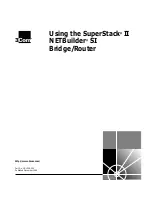
Chapter 10
Neobit 1012VA-II ADSL Ethernet Router User’s Guide
74
Hops and gateways
Each time Internet data is passed from one Internet address to
another, it is said to take a
hop
. A hop can be a handoff to a
different port on the same device, to a different device on the same
network, or to a device on an entirely different network.
When a hop passes data from one type of network to another, it
uses a
gateway
. A gateway is an IP address that provides initial
access to a network, just as a switchboard serves as a gateway to a
specific set of phone numbers. For example, when a computer on
your LAN requests access to a company’s web site, your ISP
serves as a gateway to the Internet. As your request reaches its
destination, another gateway provides access to the company’s
web servers.
Using
IP routes to define default gateways
IP routes are defined on computers, routers, and other IP-enabled
devices to instruct them which hop to take, or which gateway to use,
to help forward data along to its specified destination.
If no IP route is defined for a destination, then IP data is passed to a
predetermined
default gateway
. The default gateway serves like a
higher-level telephone switchboard; it may not be able to connect
directly to the destination, but it will know a set of other devices that
can help pass the data intelligently. If it cannot determine which of
these devices provides a good next hop (because no such route
has been defined), then that device will forward the data to
its
default gateway. Eventually, a high level device, using a predefined
IP route, will be able to forward the data along a path to its
destination.
Do I need to define IP routes?
Most users do not need to define IP routes. On a typical small home
or office LAN, the existing routes that set up the default gateways
for your LAN computers and for the Neobit 1012VAprovide the most
appropriate path for all your Internet traffic.
On your LAN computers, a default gateway directs all
Internet traffic to the LAN port on the Neobit 1012VA. Your
LAN computers know their default gateway either because
you assigned it to them when you modified their TCP/IP
properties, or because you configured them to receive the
information dynamically from a server whenever they
access the Internet. (Each of these processes is described
in the Quick Start instructions, Part 2.)
On the Neobit 1012VAitself, a default gateway is defined to
direct all outbound Internet traffic to a router at your ISP.
This default gateway is assigned automatically by your ISP
whenever the device negotiates an Internet connection.
(The process for adding a default route is described on
page 77.)
You may need to define routes if your home setup includes two or
more networks or subnets, if you connect to two or more ISP
services, or if you connect to a remote corporate LAN.










































